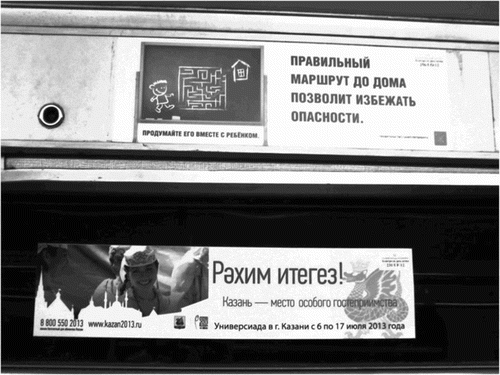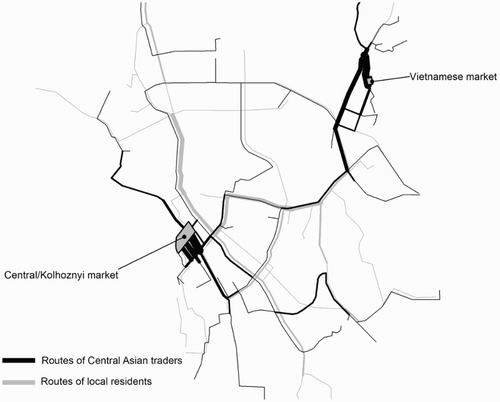ABSTRACT
This paper questions the effectiveness and usefulness of the Russian government's policies of migrant integration. Using a unique combination of ethnographic research methods (observations, interviews and survey) with methods from psychology (cognitive mapping) and urban studies (GIS mapping), I depict the presence of Central Asian migrants and their interaction with local long-term residents in two cities of the Russian Federation: Kazan and Saint Petersburg. On the basis of my findings, I argue that the readability (defined as the ease with which the city can be ‘read’ and understood) and legibility (defined as the degree to which individual components of an urban environment are recognizable by their appearance) of urban space in Kazan have positive effects on the relationship between these two communities, while the ambiguity and uncertainty of urban identity in Saint Petersburg make the life of migrants very vulnerable and unpredictable, and result in the growth of xenophobic views among the local residents. This allows me to argue that the policy of migrant integration will be more successful if it is built on learning to live with differences, instead of trying to ‘Russify’ migrants or create various forms of supra-ethnic identity.
Introduction
Riding the late-evening metro train in Saint Petersburg one day, I was astonished to see two very contrasting posters next to each other. The one on top depicted a chalkboard drawing of a schoolboy, a labyrinth of streets in Saint Petersburg and the boy's home. The text suggested: ‘A proper route home can help avoid danger. Think it through with your child.’ The image below included a smiling girl in a traditional costume, with the text: ‘Welcome! Kazan is a place of special hospitality.' The girl was inviting metro riders to attend the University Olympic Games held in Kazan in the summer of 2013. My astonishment emerged from the realization of how well these two images, accidentally posted next to each other, represented the main idea of my research: that senses of security and hospitality are embedded in the urban experience and mutual perception of two distinct groups – the local residents of two Russian cities, Kazan and Saint Petersburg, and the Central Asian traders who also work and live there ().
Nearly 5 million migrant workers from Central Asia work in Russia today (Dmitriev and Pyaduhov Citation2011; Abashin, Citation2012). Most of them are concentrated in large Russian cities, such as Moscow, Saint Petersburg and Yekaterinburg. In its scale, labour migration to Russia currently is second to the United States (Laruelle Citation2013). A declining Russian population and the demand for labour on the one hand, and poverty and unemployment in Central Asia on the other, has resulted in a significant Central Asian presence in urban Russia. This phenomenon is attracting attention from experts, policy analysts, state officials and academic scholars. Laruelle (Citation2013) points out that today most of the academic research on migration from Central Asia to Russia is done within the field of sociology and anthropology and studied either at the macro level (quantitative studies) or at the micro level (ethnographies of everyday life of migrants). Meso-level studies are missing. I would add that there are many economic studies of Central Asian migration, but very few contributions from other fields. This research attempts to partially fill in these gaps. On the one hand it brings in methodologies from psychology and urban studies, such as cognitive and GIS (geographic information systems) mapping, respectively, thus expanding the traditional palette of migration research instruments; on the other hand, its main object of study becomes an urban neighbourhood – a meso-level unit that is smaller than the national macro level or that of urban statistics, but larger than an individual migrant's life narrative.
Abashin (Citation2012) proposes that what it means to be a migrant is shaped differently in different parts of Russia and that putting everything under one denominator is a big mistake. Therefore, in this contribution, I draw my main analytical insights from a rigorous comparison of two cities in order to see how contextual differences affect migration experiences.
The conceptual inspiration for this paper is drawn partly from Reeves's (Citation2013) concept of the ‘space of uncertainty’ – the product of a specific ‘mode of governance in urban Russia that thrives less on rendering subjects legible than on working the space of ambiguity between life and law’ (p. 508). Reeves examines how a ‘boundary between being legible and illegible to the state is blurred and fraught with social and moral uncertainty’ (p. 509), and how the uncertainty and ambiguity of Central Asian migrant workers’ legal status breeds suspicion, racist thinking and everyday humiliation. Abashin (Citation2012) develops a similar discourse on the ambiguity of the term ‘migrant’ in contemporary Russian legislation and public discourse. He shows that there is no one agreed-on definition of who is a migrant, that different competing classifications are used interchangeably depending on who uses them, and that such ambiguity eventually results in associating ‘migrants’ with ethnically or racially different ‘others’ and with various ‘threats’ and ‘dangers’ for Russian society (Abashin Citation2012; Mukomel Citation2013).
What I take from these studies is the detrimental character of uncertainty and ambiguity that characterize the interaction between migrants and locals, between migrants and the state, and among migrants themselves. I apply these categories (uncertainty and ambiguity) to the analysis of urban space and I contrast them with readability and legibility as positive and beneficial features of the urban environment. Readability is the ease with which the city can be ‘read’ and understood, while legibility means the degree to which individual components of an urban environment are recognizable by their appearance. For example, in the same study mentioned above, Reeves shows that familiarity with urban space narrows the gap between ‘documentary’ and ‘real’ legality for migrant workers and reduces their exposure to certain risks. On the basis of my research findings, I argue that indistinctness and ambiguity in the socio-spatial organization of a city only reinforce the uncertainty and fear of the ‘other’, while clarity and legibility can make it easier for communities ‘in conflict’ to successfully navigate urban space and feel safer in it.
By putting forward this argument, I am making a case for the reinforcement of distinctive cultural and spatial identities and for building on differences instead of similarities. This argument is based on Montgomery, Seligman and Wasserfall's concept of learning to live with differences instead of overcoming them: ‘Only by learning how to live together differently can we live together at all.'Footnote1 This is a case against the mainstream strategy of the Russian government and other organizations working with migrants – strategies which are predominantly motivated by the idea of integration of migrants and manifested in new laws and policies. In 2010 a special unit was created within the Federal Migration Service to foster the integration of migrants (Dmitriev and Pyaduhov, Citation2011). In 2012 two important policy documentsFootnote2 were introduced by the Russian government which identified the social and cultural adaptation and integration of migrants, and the formation of constructive relationships between migrants and the host community, as their main goals (Mukomel Citation2013). The Federal Migration Service started working with leaders of migrant diasporas, as well as with religious organizations, such as the Russian Orthodox Church, which is currently very active in offering Russian-language courses for migrants and developing various manuals to teach migrants how to live and behave properly in Russian society.Footnote3
In the last few years, the idea of the integration of migrants into Russian communities has also received significant attention from local Russian scholars and experts on migration (Ikontcev and Ivahnyuk Citation2013; Mukomel Citation2013). The vision of integration varies from scholar to scholar and ranges from recommendations for all migrants to learn how to live the Russian way, to more multicultural perspectives, which leave more room for the migrants’ own cultures, languages and traditions. Yet, the general tendency in these reports is to promote the idea of a shared culture, which is expected to unite people of different ethnic groups. In many ways, this idea is reminiscent of the Soviet idea of druzhba narodov (Friendship of Peoples), where one supranational identity overarches ethnic differences (Sahadeo Citation2007). However, as Sahadeo shows, during Soviet times, in spite of people's friendship, Central Asian workers in Moscow and Leningrad were perceived as chernye (blacks) and faced discrimination. This is one reason why today as well few authors are optimistic about the potential of such integration. They identify a number of factors that create obstacles on the way to integration, some of which are structural, while others are related to the individual and communal characteristics of the migrant and host communities: strength and encapsulation of diasporic networks; duration of migrants’ stay in Russia; language ability and education level of migrants; closed nature of the receiving society; economic difficulties; political instability; migration legislation; changing societal trends, from collectivism to individualism and competition; growing xenophobia and Russian nationalism; etc. The shared pessimism of these authors, a lack of confidence in the success of integration policies, and their very ambitious recommendations, such as to change the ‘cultures’ of both communities, once again put the whole idea of integration under a big question mark.
In my research I suggest looking at questions of integration and urban segregation from the point of view of an urban planner. I refer to Kevin Lynch and his book Image of the City (Citation1960), in which he discusses how a city's image is constructed from various categories of physical elements and strongly argues for the readability of an urban environment as one of its main positive characteristics: the easier we can ‘read’ urban space and its semantics, the more comfortable we feel in the city. I suggest that we can expand Lynch's conceptualization to include the readability of urban socio-cultural ‘text'. Segregation and socio-cultural distinctness of space is not necessarily bad; in some cities it helps us better understand and navigate the contested urban space, thus making everyday urban experience more comfortable. On the contrary, inability to comprehend the urban space and its socio-cultural organization creates cognitive dissonance for the urban dwellers and complicates their relationships with each other. In my study, I compare the readability and legibility of urban space in Kazan with the confusion and ambiguity of urban space in Saint Petersburg. Saint Petersburg is a modern, buzzing metropolis, whereas Kazan is a smaller town. Variations in ‘readability’ between these cities certainly have something to do with their demographic fabrics, which influence different types of urban experiences. However, I believe that there are other factors at play as well. To understand these, I use a diverse palette of research instruments: observations and mapping; in-depth semi-structured interviews; cognitive mapping; and GIS mapping.
The research team involved in this study walked and biked the streets of the two cities with the purpose of recording on the map all manifestations of Central Asian presence.Footnote4 In Kazan, these were mostly cafes and restaurants with traditional Central Asian cuisine, while in Saint Petersburg there were also many Central Asians working in shops and non–Central Asian cafes and selling fruits.Footnote5 In addition, we made observations on the markets in both cities. Another major block of research involved conducting interviews with both Central Asian traders and long-term urban residents.Footnote6 The interviews were structured around the questions of their daily use and navigation of the city and around their perception of and contact with each other. It so happened that the easiest way to reach the Central Asian migrant community was through the market traders. Therefore, after a few initial attempts to connect to migrants in other professions, we decided to limit our occupational choice to traders. The three main ethnic groups of traders were Kyrgyz, Uzbek and Tajik; in this paper I will refer to all of them as Central Asians. I understand that this is a much-criticized generalization, for example by Abashin (Citation2012). Still, since our main focus is not on ethnicity but on space and on the relationship with the host community, I opted for this larger classification.
Respondents were asked to draw cognitive maps of their respective cities on the basis of their familiarity and everyday experiences. Later, on a printed map, they were asked to indicate places where they live and work and places they frequently visit. While drawing they also elaborated on these daily practices and on the significance and meanings of certain places, and shared stories associated with important locations. The novelty of this research is in the innovative use of GIS software to visualize the cognitive and observational maps. Using GIS capabilities we visualized the answers of our respondents and the physical manifestations of migrant presence. We also visualized places and regions associated with migrants, and places and regions which both communities considered safe or dangerous. These visualizations helped us produce important insights and conclusions about the ways these two communities live and interact in the two cities, which I will discuss in the following sections.
Central Asian traders versus local residents and Kazan versus Saint Petersburg
In this section, I compare the two cities as regards the attitude of local residents and Central Asians towards each other, friendship ties between them, local residents’ characterizations of Central Asian migrants and memories of interacting with them, and, finally, accounts of Central Asians’ experiences in these cities. One major finding that runs through almost all of the analysis is that the relationship between migrants and locals in Kazan is more positive than it is in Saint Petersburg.
When we compare the attitude of local residents towards Central Asians in the two cities, we can point to some significant differences. We can notice that the majority of locals in Kazan are rather neutral, while in Saint Petersburg attitudes are more diverse: there are twice as many local respondents who perceive migrants negatively, but there are also twice as many who hold a positive attitude (). Kazan represents a more centrist model, which implies more stability, more tolerance and an unbiased attitude. Saint Petersburg embodies a more polarized attitude, with more opinions at the extreme ends of the spectrum. This means less stability and predictability, and more uncertainty for migrants, who are less sure about what to expect from the locals. In the context of growing xenophobia and nationalism in Russian society, a neutral attitude may indeed seem safer and more preferable for migrants.
Table 1. Attitude of local residents towards Central Asians in two cities.
Another important factor is friendship between these two communities. As it turns out, more local residents in Kazan (58%) have friends among Central Asians than in Saint Petersburg (37%). The average number of Central Asian friends per local resident in Kazan is also higher (3.7 versus 1.4). We could observe these kinds of friendship in Kazan's markets. Central Asian traders had many local Russian and Tatar friends, particularly within the trader community. Markets, as spaces of daily interaction of traders of diverse ethnic groups, develop a unique kind of solidarity and sense of belonging. We could observe the intimacy of interaction of market neighbours: traders often joked, teased each other, had lunch together, and looked after each other's merchandise when someone was away. During one of the Federal Migration Service raids, we observed a local Russian trader hiding his Central Asian market neighbour, who had no official registration, behind merchandise inside his own container. Traders in Kazan also shared stories of how they went for picnics together with local friends and invited them for celebrations. Such ‘warm relationships’ were more difficult to find in Saint Petersburg.
We asked local residents to share accounts of their real-life encounters with migrants or give more extensive comments. In Kazan, half of the accounts were positive and half negative. In Saint Petersburg, two-thirds of the accounts were negative. Saint Petersburg, being the cultural capital of Russia, has a significant layer of intelligentsia with progressive outlooks, who not only criticize the xenophobic nationalist discourse and sympathize with migrants, but also volunteer for various kinds of projects helping them with legal assistance or learning Russian. Two programmes implemented in the city are Tolerance-1 and Tolerance-2 (described later), which engage significant numbers of local residents in activities aiming to help migrants integrate. Local organizations like Memorial conduct much advocacy work supporting migrants of different ethnic groups. Yet, Saint Petersburg also has a larger share of local residents from the nationalist camp, many of them representatives of the younger generation (Rozanova Citation2012).
Finally, to compare the two cities we can look at the experiences of Central Asian migrants. The trend is the same: accounts in Kazan are more positive than in Saint Petersburg. shows that while the numbers of negative and neutral accounts are similar, there are twice as many positive stories in Kazan.
Table 2. Experiences of Central Asians in Kazan and Saint Petersburg.
Positive stories describe the achievements of migrants and their family members, different kinds of events in their life, the quality of living, etc. One trader boasted of the accomplishments of his son, who became such a successful soccer player in Kazan that he was invited to train for the Barcelona club in Spain. Another trader boasted that he had won four medals in wrestling while living in Kazan. Yet another trader described how his daughters won choreographic competitions and were given tickets to a resort on the Black Sea. Our respondents also shared many stories of economic achievements, such as purchasing apartments and cars. In Kazan particularly, purchasing an apartment was something common for many Central Asian traders. For several of them, Kazan also became a place where they met their future spouses.
There were many stories of positive interaction with locals. One Uzbek boy revealed how he had saved the life of a Russian boy who was almost drowning in a lake. Similarly, a Kyrgyz man described how they were driving to the city centre one day and saw a burning car; they stopped and saved the passengers. One Tajik trader described how he and his friends found a lost child under a bridge and then helped him find his parents. Another Tajik man spent four hours helping a Russian man dig through some trash in order to find a folder of important documents, which he had lost the night before while drinking with his friends. Perhaps less dramatic but just as important are stories that describe how respondents organize celebrations and meals, how they invite their friends from among local residents, and how they participate with them in various holidays organized in the city. Some respondents described how they try to respect people here, for example by offering them their seats on public transport. An Uzbek woman described that she had a very good neighbour across the staircase where she lives, and that they had become like family to each other. In some cases, relations move beyond friendship: one Tajik had fallen in love with a Russian woman and they had been in a relationship for two years. Also there was a Kyrgyz woman who married a local Russian man in Kazan and now has many Russian friends.
Central Asian stories from Saint Petersburg had more emphasis on the quality of living. Saint Petersburg is a very beautiful city, and many Central Asians appreciate the architecture, the urban spaces and the civilized nature of relations between people. Even McDonald's is perceived by some younger respondents as something prestigious: ‘With my friends we often go to McDonald's and then walk around with some girls. This is interesting for me. I am planning to live here.' Initiation into this urban environment is sometimes described with a sense of humour: ‘When I first stepped on the escalator, I thought this was the metro’, said a young Kyrgyz migrant.
At the same time, Central Asian respondents shared negative stories – more so in Saint Petersburg. Such stories included encounters with the police and the local authorities, the experience or perception of racism, and complaints about children forgetting their mother tongue and roots, as well as about boring life. One trader complained that he had had his merchandise stolen in the market, and when he went to the police, the officers did not do anything about it, but instead tried to extort money from him. Several traders mentioned that they always had to be on the lookout for police, and that they hid or fled from the market when the police conducted their raids. There were also many stories of respondents being arrested by the police or by the Federal Migration Service.
Several Central Asians in Saint Petersburg complained about the racist attitude of local residents, about verbal abuse and about the danger of skinheads. One trader said that those skinheads who have already killed someone wear red shoelaces, while those who have not wear white ones. Other migrants complained about their children being discriminated against at school. Perhaps this is one reason why children try to adjust to the local conditions and prefer to affiliate themselves with local Russians rather than with other Central Asians, a process of adaptation that some parents negatively perceive as ‘Russification’.
However, the most frequent complaint is about how boring and dull life can be in Russia. For many Central Asian traders, the market is the main place where they spend their day. To earn better, they have to work long hours, and as soon as they finish work, they rush home. Particularly in Saint Petersburg, they try to avoid public spaces, and many have little in the sense of entertainment because they do not have legal status and can be deported if caught by the police. ReevesFootnote7 refers to De Genova's (Citation2002) term ‘deportability’, which is about not just deportation but the condition of uncertainty that always looms over migrants’ heads. She shows how this condition of deportability defines migrants’ lives in the city and how very important it is for a migrant to engage in strategies of invisibility, described as ‘moskvada korumboybuz’ (we try to be invisible), ‘tynch zhashaibyz’ (we live quietly), or ‘koidon zhoosh zhurobuz’ (we are quieter than a lamb). This shapes a set of embodied feelings defined by Reeves as ‘living from the nerves’. Among our respondents, this condition of deportability also significantly limits their engagement with the city and results in comments such as ‘the days are all the same here’ and ‘there is nothing fun in my life: just work and home’.
The contrast between the two cities does seem a bit grotesque, and of course in Kazan there were also negative stories from both migrants and local residents. However, the cumulative results of our survey presented in this section lead us to conclude that the relationship between long-term residents and Central Asian traders is largely more positive in Kazan than in Saint Petersburg. The big question emerging from such empirical findings is, why is this so? So far, I have provided no explanations. This will be done in the next two sections, where I analyze each city individually and then return to my main argument about urban diversity and readability/ambiguity within the urban socio-cultural environment.
Kazan
Since its establishment in the tenth and eleventh centuries, Kazan has been a place of continuous contestation. From 1552, when the city was completely subjugated by the army of Ivan Groznyi and lost its sovereignty, we can observe a new period in its history – one of coexistence between its two main ethnic and cultural groups: Russian Christians and Tatar (Bulgar) Muslims. Its early years were a time of repression, when many Muslims were forcefully Christianized, mosques destroyed, and Tatars forced to live outside the city, in an area on the left side of the Kabanka River, which then became known as Tatarskaya Sloboda.Footnote8
Muslims and Christians were not allowed to live together, and from there on we can observe the formation of a divided city. The traces of this division are still very noticeable today: almost all the churches are on one side of the Kabanka, all the mosques on the other. By the end of eighteenth century, Kazan had expanded its boundaries, and all of its slobodas, including two Tatar slobodas, became part of the city. Alishev (Citation2005) describes how throughout Kazan's history there was a continuous confrontation between Muslim and Christian city residents, yet the everyday experience of living together over several centuries eventually helped the two communities dissolve barriers and united them in the joint class struggle against feudal and later capitalist exploiters. Kazan also became a place where two cultures, Eastern Islamic and Western Christian, were developing together and contributed to the exchange of ideas and the formation of strong ethnic identities. Perhaps the most prominent manifestation of such development was the formation of the Jadidist movement, which combined elements of strong nationalism, a revived Islam and a progressive modernist perspective.
This brief overview of Kazan's history shows how almost a millennium of contestation between Russians and Tatars resulted in the formation of a city divided along ethnic and religious boundaries. Yet at the same time, this was also a millennium of coexistence, which produced to some degree hybrid, but more so distinctive, cultural groups with experiences of how to share this urban space.
The post-Soviet era then brought a revival of religious and ethnic sentiments, which again reinforced these distinctions. That is why today, when Central Asian traders arrive in Kazan, they find environments that are already divided and culturally distinct. According to the census of 2010, Russians make up 48.6% of Kazan's population, Tatars 47.6%. Being Muslims and speaking Turkic languages, the traders share religious and linguistic identities with local Tatars. Upon arrival, most of them settle on the left side of the Kabanka – an area that for five centuries has been primarily associated with Muslims. Thus, they are not perceived as a minority group and have become well embedded in the cultural and spatial structure of the city. They are perceived by local Tatars to some degree as brothers and sisters in Islam, and they are perceived by Russians as members of the Muslim half of the city. This is how they enter into local ethnic and religious dynamics, which seems to play to their advantage.
The spatial organization of contemporary Kazan is strongly connected to its administrative division into seven rayons (districts). Respondents in our survey frequently referred to these districts when they talked about the cityscape. These districts also turned out to be important markers of Central Asian migrants’ presence in the city, which in the perception of our respondents was associated with two large markets (the Central and the Vietnamese) and various Central Asian cafes and restaurants. a shows their location. The largest number of Central Asian cafes (56%) and the largest Central Asian market are in the Vakhitovskii District. The same district has the largest number of Central Asian migrants living there (47% of all surveyed migrants) and is also a region where a majority of migrants (45%) spend their free time (b, c).
Figure 2. (a) Location of Central Asian cafes and markets. (b) Places of Central Asians’ residences. (c) Places where Central Asians spend their free time.
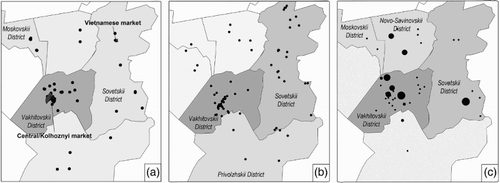
These maps and statistics show that Central Asian migrants in Kazan are strongly concentrated in one main area in the historical city centre: the western half of Vakhitovskii District. The district is divided into two distinct halves by the Kabanka River. The eastern half is well maintained; it hosts all main administrative buildings, such as the local kremlin, and various museums and churches. The western part, the historically Muslim area of the city, where the market is located, is quite run down: buildings are old and in need of renovation, and the roads are in very poor condition. To some degree, the contrast between the two parts of Vakhitovskii District illustrates the policy of the city administration, which for some reason continues the historical tradition of neglecting the Muslim part of the city, as described by Alishev (2005).
Similarly, the city administration has a negative perception of the Central Market, which it considers a space of vice and informality. Our interviewees from the market mentioned several times the rumours about how the market was going to be wiped out in the preparations for the University Olympic Games. The Central is the largest market in Kazan. It has sections where various food products are sold and sections for other kinds of merchandise – clothes, electronics, kitchenware, etc. The market, with its simple metal and wooden stalls, can be perceived as a very informal place; visually it stands in sharp contrast to the more formal and fancy shopping malls in other areas of Kazan.
The western part of Vakhitovskii rayon also has a strong Islamic character. There are many historic mosques and a whole section of streets with shops selling Islamic merchandise. The significant presence of Central Asians only strengthens this Islamic feel. Being in this area, one cannot but notice how different it is from the other half of the city centre: cafes and shops have Islamic names, which often are written in Arabic-style fonts. There are many women wearing long dresses and hijabs. On one of our first days of research we had lunch in the Soyombike Cafe on Gabdulla Tukai Street and were very surprised to see it full of young women in Islamic attire. It later turned out that just across the street from this cafe there was a madrasa for girls. The language, signs, architecture and dress were all symbols making this space very distinct and readable. Its strong contrast to the western part of Vakhitovskii District also makes this urban territory distinct and legible. The readability and legibility of the urban centre in Kazan thus indicate how physical, cultural and cognitive spaces coincide and reinforce the local urban identity ().
Figure 3. Images from the western side of Vakhitovskii rayon: a mosque near the market; the Uzbek cafe Uzgen; and an old building illustrating the run-down character of the neighbourhood.

The Central and Vietnamese Markets were the main places of employment for our Central Asian respondents. Traders spend significant amount of their time in these bazaars. Accordingly, they try to find places to live not too far away, preferably within walking distance, so that they do not have to use public transport. This is one of the main strategies that helps migrants minimize contact with locals and with the police. Accordingly, markets play a very important role in structuring the migrants’ perception of the city. The analysis of cognitive maps of Kazan drawn by such traders on blank sheets of paper and without any specific instructions shows that bazaars are very significant place makers for Central Asians. In some maps, bazaars occupy the central position on the page (b); in others they are shown as the main starting/destination points (c). In still others they are shown in a very large size, while in some of the maps, there is almost nothing but bazaars (a).
Figure 4. Maps of Kazan drawn by Central Asian traders: (a) nothing but markets on the map; (b) markets occupy the central place on the map; (c) markets are drawn as the main starting or destination points.
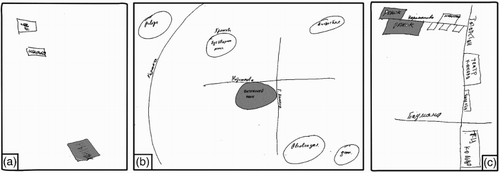
Interestingly, this physical presence of Central Asians strongly correlates with the perception of Central Asian presence among the local residents: 61% of local respondents associate migrants with the Vakhitovskii District and the Central Market (a). But what is even more interesting, for local residents, the Vakhitovskii rayon is also the safest rayon in the city (b, c). These maps clearly show that local residents do not consider places associated with migrants dangerous. This confirms our findings from the questionnaire survey results: migrants in Kazan are not associated with danger and are not perceived as a threat.
Figure 5. Places and regions (a) associated with migrants among locals; (b) safe for locals; (c) unsafe for locals.
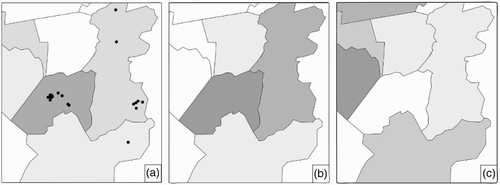
The next map () compares the routes taken from home to work by local residents and by Central Asian traders. The routes do not overlap much, and the majority of traders prefer to live within walking distance from the market. This is also evidenced by the time and mode of their journeys: traders travel to work for only 18 minutes, while locals do so for 38 minutes; 49% of traders walk to work, versus only 9% of locals. In addition, 68% of traders work in the district where they live, as opposed to only 24% of locals. Traders prefer to live near markets and walk to work for the reasons of convenience and safety (to avoid meetings with police).
We can conclude at this point that in Kazan the presence of Central Asians has a very strong spatial manifestation, in real life (as evidenced by the locations of markets and Central Asian cafes, traders’ residences, their places for spending free time and by their home–work journeys) as well as in the perception of local residents. The main neighbourhood in Kazan associated with Central Asians – the western half of the Vakhitovskii rayon – has a run-down appearance and a strong Islamic character, which results in some stigmatization, but not in a negative attitude. This is quite unexpected given all the literature on urban conflict reviewed in the introduction part of this article, and all the fears and warnings of Russian authors about the dangers of ghettoization. To explain this positive outcome, one has to remember that contrary to the many negative case studies of urban segregation, in Kazan there is a thousand-year history of interaction between the two main ethnic and religious communities associated with these places. The two communities ‘read’ each other very well, and space reinforces that readability, distinction and mutual respect or tolerance. In addition, many local Tatar residents interviewed in our survey still have regard for their historical territory on the left side of the Kabanka River, even if their families long ago moved out. The fact that the spaces and journeys of locals and Central Asians do not overlap much is perhaps another reason why the two communities coexist without significant conflicts.
Saint Petersburg
From its very establishment in the early eighteenth century, Saint Petersburg has been a multilingual and multi-ethnic city, although the vast majority have always been ethnic Russians. Among its main ethnic groups there were Germans, Ukrainians, Finns and Jews. By the time of the revolution in 1905–07 there were about 150 ethno-cultural associations in the city (Rozanova Citation2012). However, during the repression years of the 1930s, all these organizations were closed down because of the fear of espionage. The siege of Leningrad in 1941–44 reduced the size of the city population to one-sixth of its peak size. In the postwar period, the ethnic composition of the city started to change, with more migrants coming from the Volga region, the Caucasus and Central Asia (Rozanova Citation2012). The rates of immigration rapidly increased in the post-Soviet period, and today Saint Petersburg is second only to Moscow in the number of migrants. In 2010, the number of migrants in the city reached 1.5 million, out of a total population of 5.1 million. Migrants produced 13% of city revenue (Rozanova Citation2012). The majority of migrants are from nearby and other regions of Russia, and according to the 2010 census, such traditionally Muslim ethnic groups as Tatars, Uzbeks, Tajiks, Kazakhs, Bashkirs and Turkmens together make up only about 2% of the city.
Unfortunately, Saint Petersburg is also second in the number of hate crimes; 15 people were killed and 39 assaulted in 2008 in Saint Petersburg and the Leningradskaya oblast (Rozanova Citation2012). The westernmost city in Russia, it also has a reputation of being one of the most racist. At the same time, there are many people representing progressive intelligentsia who defend migrants. On a graffiti in the portraits of Hitler and Putin are placed next to each other, perhaps suggesting some similarity between fascism and contemporary Russian migration policies and the sign under it says “Never again”. Saint Petersburg has developed and introduced two very ambitious programmes on interethnic tolerance: Tolerance-1 and Tolerance-2. The first, launched in July 2006, aimed to change the public opinion of Saint Petersburg residents about representatives of different ethnic groups. The main idea was to spread the concept of a supra-ethnic identity of peterburgets – a resident of Saint Petersburg. The main slogan of this programme was ‘Petersburg unites people', and its activities included various kinds of cultural, social and scientific events. While doing our research we came across a graffito with this slogan. Interestingly, next to the main slogan ‘Petersburg unites people’ someone added the sceptical word pochti (almost), which was later painted over (). The programme's outreach was quite significant; its main mistake was that it did not engage the migrant community itself (Rozanova Citation2012).
Figure 7. Graffiti: (a) ‘Petersburg unites people' (with ‘almost’ added and then painted over); (b) ‘Never again'.
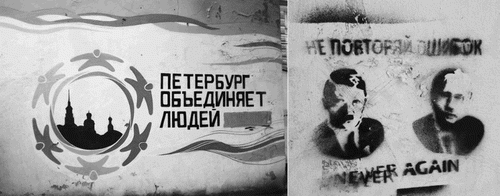
The Tolerance-2 programme addressed this failure: its main focus was on the migrants and their children, helping them integrate into city life (Rozanova Citation2012). During our research we interviewed a local Russian young man who was volunteering for this programme, spending a few hours a week to help the children of migrants learn Russian. The programme, however, remained within the boundary of a joint supra-ethnic identity concept as a solution to the problems of growing racism. As such, it fit well the Federal Migration Service policy of migrant integration.
When we first arrived in Saint Petersburg from Kazan and asked our landlady about the location of Central Asians in the city, we received a puzzling answer: ‘What do you mean? They are everywhere!’ We thought that maybe she just did not know. However, as we progressed with our fieldwork, we came to understand that she was quite right. In contrast to Kazan, there was not one strong concentration of Central Asians in this city. Rather, these migrants were more or less evenly spread across the whole urban area. shows the location of Central Asian markets, restaurants, food shops and fruit vendors in Saint Petersburg.
Figure 8. Physical presence of Central Asians in Saint Petersburg: (a) markets; (b) food shops; (c) restaurants; (d) fruit vendors.
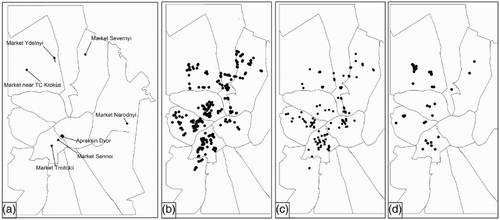
Saint Petersburg has three times the area of Kazan, and four times the population. That is why the research team were not able to cover the entire city. We decided to make observations on a diagonal stretch from the south-west to the north-east that cut through the city centre and other main kinds of neighbourhoods. Our analysis does not reveal any large concentrations of Central Asians on the city scale, but it shows small concentrations around metro stations. In contrast to Kazan, administrative districts in Saint Petersburg are not important place markers. People hardly refer to them; instead, when they talk about their use of space, they extensively use the names of metro stations. Interestingly, metro stations have also become the main magnets for Central Asian traders, because the metro is the most popular mode of public transport in the city, and large numbers of potential customers pass through them on a daily basis. The enlarged section of the northern part of the city () illustrates how Central Asians tend to locate near the station or on the streets leading to the stations.
Figure 9. Location of food-shops, cafes and fruit stalls where Central Asians work, in relation to metro stations, in Saint Petersburg.
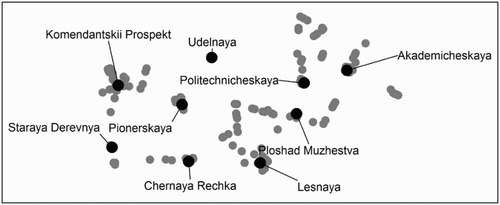
The analysis of Central Asians’ places of residence and recreation shows that they are not strongly concentrated either (). As in Kazan, traders prefer to live near markets. Their average time to work is 19 minutes, versus 32 minutes for local residents; and 44% of Central Asians walk to work, versus 23% of locals. However, because there are many more markets and they are spread across the city, the map of Central Asians’ residence is rather spread out, too. Also, as in Kazan, markets play a very important role in the Central Asian traders’ life, which is reflected in how they draw their own maps of the city: in some maps markets occupy almost half a page and have a lot of details, whereas the city is drawn in a very abstract and limited way.
Figure 10. Saint Petersburg: (a) places and regions of Central Asian traders’ residence; (b) places and regions where Central Asian traders spend free time.
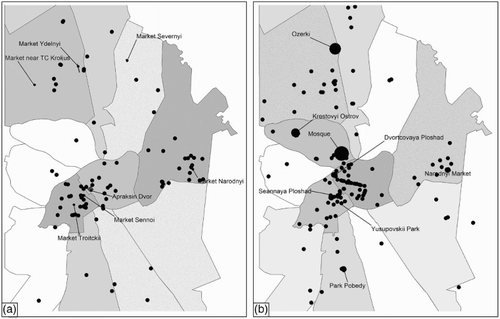
How does the physical presence of Central Asians correlate with the perception of their presence among local residents? In contrast to Kazan, not significantly. In addition, there is little correlation between areas associated with migrants and areas that are perceived as safe or dangerous by locals. shows that some areas associated with migrants are perceived as dangerous, while others are understood to be safe.
Figure 11. Saint Petersburg: (a) places and areas associated with migrants among local residents; (b) places and areas perceived by local residents as safe; (c) places and areas perceived by local residents as dangerous.

One explanation of this ambiguity again is linked with the metro. The metro, being the main mode of public transport in Saint Petersburg, becomes a place where locals and Central Asians regularly meet. Even though Central Asians prefer to walk to their workplace, some of them (15%) cannot avoid a metro ride. shows that the travel routes of Central Asian migrants and local residents overlap much more significantly than they do in Kazan.
This again shows that the metro creates a parallel urban space – one which is underground and which adds additional layers of complexity to the ways the two communities locate each other in the city. Central Asians referred to travelling in the metro as a dangerous experience, because it is an enclosed space with no options for escape. This is where they are most likely to be stopped by the police or the Federal Migration Service, and sometimes become targets of racist attacks. A clear illustration of this is the case of ‘white train’ actions, which took place in Moscow in 2013 after the infamous events in Biryulevo, when crowds of Russian young people attacked migrants inside the metro trains.
The visual presence of Central Asians in Saint Petersburg had much more ambiguity than in Kazan. If in Kazan we saw many Central Asian women freely wearing hijabs, in Saint Petersburg we saw many Central Asian girls bleaching their hair and fashioning it in such a way that it enclosed their faces on the sides and made them look more like Russians. In contrast to the streets of Kazan – where Central Asian identity was emphasized, particularly in the names and decorations of Central Asian cafes and restaurants – in Saint Petersburg, many Central Asian cafes ‘hid’ behind more traditional Russian names or different kinds of ethnic food, for example Japanese sushi. According to our observations, every second small shop with daily consumer products had Central Asian traders in it. However, the shops almost never used Central Asian names either.
The analysis of maps in Saint Petersburg presented in this section clearly shows the differences from Kazan. Saint Petersburg, being a larger city with a more complex spatial organization and the metro as its main public transport, does not show a strong spatial concentration of Central Asians. Instead, the spaces of locals and Central Asians significantly overlap, and both communities have many more chances to meet each other on a daily basis. In the case of Saint Petersburg this creates a potential to bring these groups closer, but at the same time it is likely to generate conflicts. This unpredictability and ambiguity of social and spatial organization produces a much more vulnerable urban space, prone to all kinds of unpredictable developments. In addition, Central Asians, being recent arrivals in Saint Petersburg, are clearly a minority group, in relation to their appearance, language, culture and religion. This makes their situation more vulnerable than that of their compatriots in Kazan and forces them to hide their identity. As a result, it makes the urban space even less readable and understandable for both local residents and for migrants and adds to the overall urban confusion. The tolerance programmes introduced since 2006 do not help either of these communities solve these problems, because their main goal is the abstract supra-ethnic identity of peterburgets, which complicates matters and – according to local respondents – creates only more confusion.
Conclusion
In this paper I have offered readers an unusual perspective on the relationship between the long-term local residents and more recent arrivals in Russian cities – labour migrants from Central Asia. The methodological uniqueness of this research was based on the rigorous comparison of the two cities, on the use of meso-level research elements, such as urban districts and neighbourhoods, and on the combination of more traditional sociological methods with rarely used instruments from the fields of psychology and urban studies. The main product of data analysis, maps of migrants’ presence and their interaction with local communities and urban environment, helped me visualize the image of a ‘divided city’ and develop a three-step conclusion to this paper, each step building on the previous one.
First, the results of our questionnaire survey reveal that relations between Central Asian migrants and long-term residents in Kazan are much better than they are in Saint Petersburg. Second, the reasons for such differences can be found in the histories of both of these cities and the socio-cultural, economic and political organization of their urban spaces. Kazan, a city with a very long history of struggle and coexistence of Russian Christians and Tatar Muslims, produced very strong ethnic and religious identities that are deeply embedded in the spatial structure of the city. For today's Central Asian migrants and long-term local inhabitants these patterns are well readable and easy to navigate. Saint Petersburg is a city with a more complex and ambiguous spatial matrix. It makes life for both communities less certain, more unpredictable, and also more difficult to comprehend and engage with. This comparison confirms the classic thesis by Kevin Lynch (1960) about the values of urban semantics and their readability and legibility as qualities of the urban environment which make the urban experience more positive and satisfactory. It also confirms more recent critiques of uncertainty and ambiguity (Abashin Citation2012; Reeves, Citation2013) as urban conditions, which make the experiences in urban space of migrants very difficult and result in growing xenophobia and racism in the local community. My third conclusion draws on the previous one to suggest that just as clarity and distinctiveness of a spatial identity are necessary for peaceful coexistence of diverse urban communities, a successful policy of migrant integration must not sacrifice their unique cultural and religious identities. Contemporary policies of the Russian government to integrate migrants either by ‘Russifying’ them or by creating various kinds of supra-ethnic identities so far have failed. I would like to return here to the earlier cited statement by Montgomery, Seligman and Wasserfall: ‘Only by learning how to live together differently can we live together at all.'
Acknowledgements
I would like to acknowledge the help of my research colleague Nurzat Sultanalieva and the team of students from the Anthropology Department at the American University of Central Asia: Alexei Kosterin, Maria Marchenko, Tynchtyk Bakyt uulu, Aigerim Tabysheva, Rashida Khasanova and Alexei Mun. I would also like to thank Madeleine Reeves and Sergei Abashin for their feedback on my first draft and Philipp Schroder for his continuous encouragement.
Disclosure statement
No potential conflict of interest was reported by the author.
Additional information
Funding
Notes
1. CEDAR (Communities Engaging with Difference and Religion), http://www.cedarnetwork.org/about-us/mission-vision/, accessed 14 January 2015.
2. ‘Koncepciya gosudarstvennoi migratcionnoi politiki Rossiskoi Federatcii na period do 2025g.’; ‘Strategiya gosudarstvennoi natcionalnoi politiki Rossiiskoi Federatcii na period do 2025g.’ http://kremlin.ru/events/president/news/15635, http://kremlin.ru/acts/bank/36512.
3. ‘Russian Orthodox Church Prepared a Textbook for Migrants’ (Avesityan Citation2014).
4. The research team included my fellow researcher Nurzat Sultanalieva and six students of the Anthropology Department at the American University of Central Asia, Kyrgyzstan.
5. Because Kazan is a smaller city, we were able to cover most of its territory. In Saint Petersburg we decided to make observations on a diagonal stretch from south-west to north-east that cut through the city centre and other main kinds of neighbourhoods.
6. All together 300 semi-structured interviews were conducted: 200 with migrants (100 in each city) and 100 with local residents (50 in each city).
7. Madeleine Reeves, ‘Living from the Nerves: Deportability, Indeterminacy and the Feel of Law’, presentation at Anthropology Club, American University of Central Asia, 18 September 2014.
8. Sloboda means a village located just outside of town.
References
- Abashin, S. 2012. “Sredneaziatskaya Migratcia: Praktiki, lokalnye soobshestva, transnationalism [Central Asian Migration: Practices, Local Communities and Transnationalism].” Etnicheskoe Obozrenie 4: 3–13.
- Alishev, S. 2005. Vse ob istorii Kazani [Everything about the History of Kazan]. Kazan: Rannur.
- Avesityan, R. 2014, December 11. Izvestia News. http://izvestia.ru/news/580608.
- De Genova, Nicholas P. 2002. “Migrant ‘Illegality’ and Deportability in Everyday Life.” Annual Review of Anthropology 31: 419–447. doi:10.1146/annurev.anthro.31.040402.085432 doi: 10.1146/annurev.anthro.31.040402.085432
- Dmitriev, A., and G. Pyaduhov. 2011. “Migranty i sotcium: Integratcionnyi i dizintegratcionnyi potencial praktik vzaimodeistviya [Migration and Society: Potential for Integration and Disintegration in Interactive Practices].” Sotciologicheskie issledovaniya 12: 50–59.
- Ikontcev, V., and I. Ivahnyuk. 2013. “Modeli integratcii migrantov v sovremennoi Rossii, Karim-Vostok”.
- Jaffe, R., and E. Durr. 2010. “Introduction: Cultural and Material Forms of Urban Pollution.” In Urban Pollution: Cultural Meanings, Social Practice, edited by E. Durr and R. Jaffe, 1–29. Oxford and New York: Berghahn Books.
- Laruelle, M. 2013. “Introduction.” In Migration and Social Upheaval as the Face of Globalization in Central Asia, edited by M. Laruelle, 5–22. Leiden: Brill.
- Lynch, K. 1960. The Image of The City. Cambridge, MA: MIT Press.
- Mukomel, V. 2013. Integratciya migrantov: Rossiiskaya Federatciya [Integration of Migrants: Russian Federation]. San Domenico di Fiesole: CARIM-East RR, Robert Schuman Centre for Advanced Studies, European University Institute.
- Reeves, M. 2013. “Clean Fake: Authenticating Documents and Persons in Migrant Moscow.” American Ethnologist 40 (3): 508–524. doi:10.1111/amet.12036 doi: 10.1111/amet.12036
- Rozanova, M. 2012. “Migration Processes and Challenges in Contemporary Russia: St. Petersburg Case Study.” Eurasian Migration Papers, N.6.
- Sahadeo. 2007. “Druzhba Narodov or Second-class Citizenship? Soviet Asian Migrants in a Post-colonial world.” Central Asian Survey 26 (4): 559–579. doi:10.1080/02634930802018463 doi: 10.1080/02634930802018463
- Vendina, O. 2009. “Kulturnoe raznoobrazie i ‘pobochnye’ effekty etnokulturnoi politiki v Moskve[Cultural Diversity and ‘Side’ Effects of Ethno-cultural Policy in Moscow].” In Immigranty v Moskve, edited by Zaonchkovskaya, 45–147. Tri Kvadrata.

